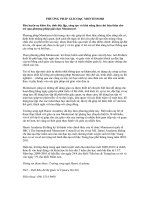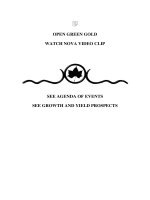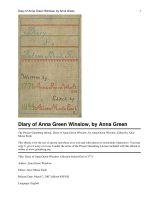Green boards montessori
Bạn đang xem bản rút gọn của tài liệu. Xem và tải ngay bản đầy đủ của tài liệu tại đây (126.17 KB, 4 trang )
Green Boards
I’m actually a bit baffled by the subject of this post, the Montessori Green
Boards. I have two pages about them in my Language manual, and they are
presented as an important exercise in developing beautiful handwriting. When
I was preparing to introduce Drama Queen to them recently, I assumed I would
likely make them, but decided to check prices online first. To my surprise, I
haven’t been able to find them anywhere! I checked several of the discount
Montessori websites as well as Nienhuis, and haven’t found anything like the
Green Boards described in my manual. A search for the term “green board”
only brought up personal-sized green chalk boards on which to practice writing
letters. Strange! I considered skipping the Green Boards, thinking that they
must not be very important if no one even sells them. However, upon further
reflection, I decided that I really like them and really thought Drama Queen
would benefit from working with them. So, I gathered materials to make my
own green boards.
The Green Boards are an extension of the sandpaper letter lessons. First, the
teacher gives the child one-on-one lessons with three sandpaper letters at a time
until the child is familiar with all the letters. Then the child is able to play
games with the letters, such as guessing which letter the teacher is tracing in
the air, writing the letters in sand, or tracing a letter blindfolded, making the
sound of it, and having a friend verify the correct sound. The next step is for
the child to work with the Green Boards, which contain several letters on each
board. The purpose of the Green Boards is to help children understand the
relationships between the written letters – all the letters of a similar formation
are grouped together on one Green Board. This is how I grouped the letters
(keep in mind that the letters are in cursive on the Green Boards):
coadgq
iuwt
nmvxyz
srjp
elbfhk
My Language manual’s description of the Green Boards is that they are similar
to the sandpaper letters in terms of the size of the letter and the fact that the
letters are made of sand, to be traced by the child. Instead of on
red boards (consonants) or blue boards (vowels), they are all on, wait for it…
green boards. I didn’t want to spend the time to cut sandpaper letters or even
felt letters, as I did when I made the Sandpaper Numerals. Instead, I wrote the
letters in pencil (about half the size of the sandpaper letters).
I then used a black Sharpie to trace over the top and bottom lines and the
middle dashed line. This is the child’s first exposure to lines in letter writing.
I traced over the letters in glue, then sprinkled sand from the children’s sand
table over the glue.
At first I was using Aleene’s Original Tacky Glue, but it wasn’t working well. I
ended up switching to plain old Elmer’s glue. In this pic (which I couldn’t get
to stay turned the right way), you can see the top with Elmer’s and the bottom
with Aleene’s.
I made these with 12×12 green cardstock I already had on hand. I didn’t have
enough of one shade of green, so I used two different shades. Also, I couldn’t
fit all the letters on one strip, so I did some taping together once the glue dried.
(I also went back over the Aleene’s letters with the Elmer’s glue.)
I let them dry overnight, then they were ready for Drama Queen’s fingers the
next day. She initially was very excited about working with them, as she is
with any new material. I first introduced the “c” board. I explained that all the
letters on that board start the same way when writing them. We went through
the letters one at a time, with me tracing, then her tracing. It was a good review
for her. Then we traced through the whole set quickly to really feel the
similarity.
After the first board, I told her she could practice with that one more on her
own, we could stop for the day and continue again the next, or we could
continue right then to the next board. To my surprise, she wanted to keep
going through every board that day. At one point, she proclaimed, “I never
knew this would be so much fun!”
I put them back on the shelf after the lesson, but that evening I taped them to
the closet door. In that location, they can be an easy visual reference when she
is writing, and they are low so that she can still trace them with her fingers at
any point.









